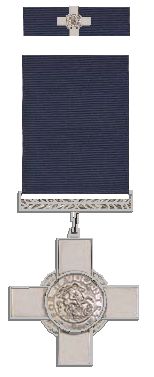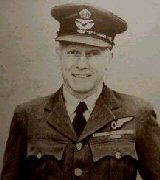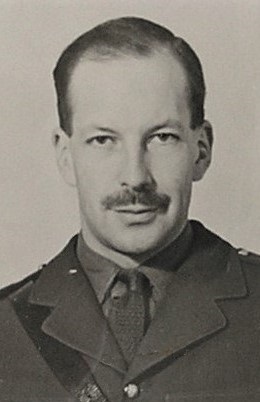The George Cross (GC) is the highest award bestowed by the British government for non-operational gallantry or gallantry not in the presence of an enemy. In the British honours system, the George Cross, since its introduction in 1940, has been equal in stature to the Victoria Cross, the highest military gallantry award. It is awarded "for acts of the greatest heroism or for most conspicuous courage in circumstance of extreme danger", not in the presence of the enemy, to members of the British armed forces and to British civilians. Posthumous awards have been allowed since it was instituted. It was previously awarded to residents of Commonwealth countries, most of which have since established their own honours systems and no longer recommend British honours. It may be awarded to a person of any military rank in any service and to civilians including police, emergency services and merchant seamen. Many of the awards have been personally presented by the British monarch to recipients or, in the case of posthumous awards, to next of kin. The investitures are usually held at Buckingham Palace.
Christopher Finney, is a former British soldier of the Blues and Royals who was awarded the George Cross for bravery under friendly fire during the 2003 invasion of Iraq.
Hugh Paul Seagrim,, nicknamed "Grandfather Longlegs", was a British Indian Army officer notable for his leadership of Karen rebels in fighting Japanese invaders in Burma during the Second World War.

RFA Bedenham was a naval armament carrier of the British Royal Fleet Auxiliary that exploded while docked in Gibraltar on 27 April 1951, killing 13 people and causing a great deal of damage to the town.

Corporal Bryan James Budd, was a British Army soldier and a Northern Irish recipient of the Victoria Cross (VC), the highest award for gallantry in the face of the enemy that can be awarded to British and Commonwealth forces.
Michael Floud Blaney, GC, known as Max Blaney, was posthumously awarded the George Cross for defusing enemy bombs during the Blitz in 1940.
Major Kenneth Alfred Biggs GC was a British Army officer of the Royal Army Ordnance Corps (RAOC) who was awarded the George Cross (GC) for gallantry in his actions in rescuing people from an ammunition train on 2 January 1946 in Savernake Forest, Wiltshire, and preventing a major explosion.
Lieutenant St John Graham Young GC was a decorated British Army officer of the Second World War.

Sowar Ditto Ram of the Central India Horse, Indian Armoured Corps, in the Indian Army during World War II was posthumously awarded the George Cross for his gallantry in helping a wounded comrade on 23 July 1944 in the vicinity of Monterchi in Italy. Notice of his award was published in The London Gazette of 13 December 1945. Ditto Ram, who was also known as Ram Ditto, was born in Gehrota, Gurdspur in India.

Wing Commander Hubert Dinwoodie, was an officer in the Royal Air Force and a recipient of the George Cross shortly after the end of the Second World War for defusing bombs in Germany in 1946.

Brigadier Arthur Frederick Crane Nicholls, was a British Army officer who was awarded the George Cross for gallantry and leadership on active service with the Special Operations Executive in Albania in 1944. He is the only member of the Coldstream Guards to have been awarded the decoration.
Aircraftman 1st Class Ivor John Gillett GC of the Far East Flying Boat Wing of the Royal Air Force was posthumously awarded the George Cross for the gallantry he displayed on 26 March 1950. He was on board a Sunderland flying boat which exploded at its moorings in Seletar. The plane sank quickly and Gillett was thrown a life belt by rescuers on a launch. He selflessly threw the belt to an injured corporal, whom the rescue team hadn't spotted, and the belt kept the man afloat until he was rescued. The corporal had by then lost consciousness and would otherwise have drowned. Gillett disappeared in the confusion and his body was discovered two days later. His citation, published in the London Gazette on 3 October 1950, noted that he had "displayed magnificent courage. His extreme unselfishness in his last living moments, which resulted in the sacrifice of his life to save another, was seen in this act of great heroism which was in accordance with the highest traditions of the Royal Air Force."
Captain Jenkin Robert Oswald Thompson GC was posthumously awarded the George Cross for conspicuous gallantry and devotion to duty. He was awarded the decoration for the courage he showed while serving as a captain in the Royal Army Medical Corps on board HM Hospital Carriers Paris and St. David in Sicily and Anzio.
Frederick William Fairfax GC was a British policeman awarded the George Cross for his heroism in chasing the armed robbers Derek Bentley and Christopher Craig on 2 November 1952. The pair had broken into a warehouse in Croydon and were pursued by Fairfax onto the roof of the building. Fairfax grabbed Bentley then Craig shot him, grazing his shoulder. Despite his injury, the unarmed Fairfax chased Bentley and managed to arrest and subdue him. More officers arrived at the scene and Constable Sidney Miles scaled the roof, to be shot dead by Craig, who then jumped from the roof after expending his ammunition, injured himself upon landing, and was arrested, then later charged with PC Miles's murder.
Hector Bertram Gray was an officer of the Royal Air Force, and a member of the British Army Aid Group, who was posthumously awarded the George Cross for "most conspicuous gallantry" in resisting torture after the Japanese occupation of Hong Kong in 1941.
Signalman Kenneth Smith GC was a British Soldier of the Royal Corps of Signals, who was posthumously awarded the George Cross for the bravery he showed on the night of 10 January 1945 on the island of Ist in the Adriatic when attached to the Long Range Desert Group.

Staff Sergeant Sydney George Rogerson,, , was a British Army soldier. He was awarded the George Cross for his heroics on 2 January 1946, after an explosion at Savernake Forest in Wiltshire.

Captain Simmon Latutin GC was a British Army officer who was posthumously awarded the George Cross, the highest British award for bravery out of combat. He won his award for the gallantry he showed in rescuing two comrades, and attempting to save a boy, from a blazing ammunition store on 29 December 1944 in Mogadishu, Somaliland.
Railwayman James William Nightall was posthumously awarded the George Cross and the Order of Industrial Heroism for the gallantry he showed during the Soham rail disaster. Nightall was an LNER Fireman on a fifty-one wagon ammunition train driven by Benjamin Gimbert. When a wagon caught fire, Nightall helped Gimbert uncouple it from the rest of the train in order to allow Gimbert to tow the burning wagon away from the rest of the ammunition wagons on the train. The wagon exploded after being towed a distance 140 yards (130 m), killing Nightall instantly, but preventing a chain reaction in the other wagons. The explosion blew a twenty-foot crater in the track, destroyed Soham railway station, and damaged 600 buildings in the village. Gimbert, who miraculously survived the conflagration, was also awarded the George Cross and Order of Industrial Heroism.






